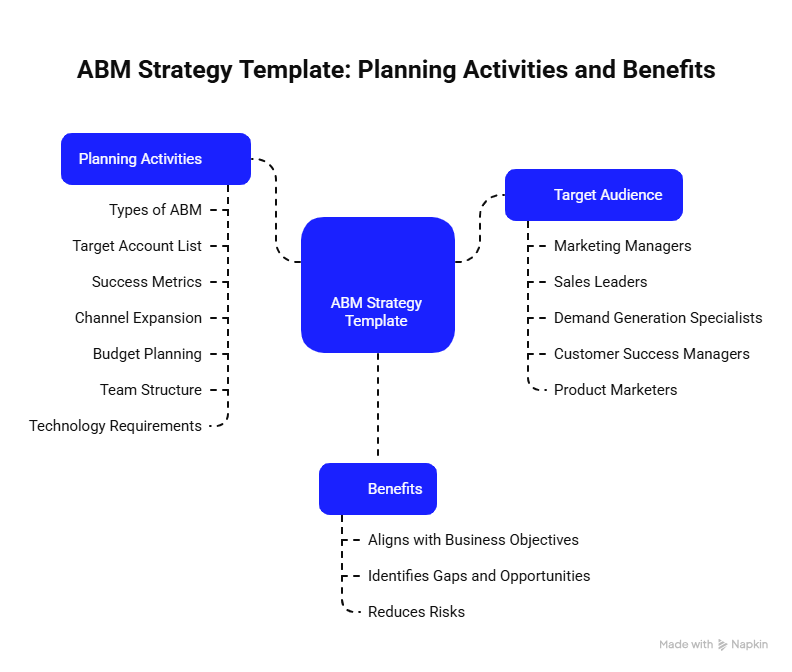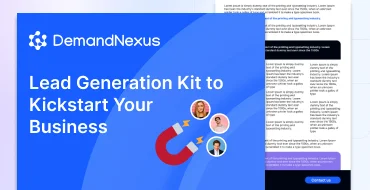Account-based marketing (ABM) templates are essential tools for B2B marketers aiming to engage high-value accounts with precision. Unlike traditional marketing plans, an ABM template provides a structured playbook to align sales and marketing, define your Ideal Customer Profile (ICP), and craft personalized campaigns. By streamlining the
ABM process, these templates help businesses boost conversions and ROI, as highlighted by Demand Metric’s findings on ABM’s high returns. This comprehensive guide explores the components of an ABM template, how to use it, and includes a real-world case study showcasing how
DemandNexus drives B2B success.
What Is an ABM Template?
An ABM template is a customizable framework that guides B2B marketers and sales teams through the process of planning, executing, and measuring account-based marketing campaigns. It acts as a
marketing strategy template, focusing on high-value accounts rather than broad
lead generation. The template includes sections for defining goals, identifying target accounts, crafting personalized content like emails, and tracking success metrics, ensuring alignment across teams.
Unlike generic marketing plans, ABM templates emphasize precision, personalization, and collaboration, making them ideal for B2B businesses targeting complex accounts with multiple decision-makers.
Why Use an ABM Template?
ABM templates offer a roadmap for executing targeted campaigns, delivering several key benefits:
- Alignment: Unifies sales and marketing around shared goals, as emphasized by Demand Metric’s research on ABM’s ROI.
- Efficiency: Streamlines planning and execution, saving time and resources.
- Personalization: Guides the creation of tailored content, such as email campaigns, for specific accounts.
- Measurability: Provides clear metrics to track progress and optimize performance.
- Scalability: Adapts to businesses of all sizes, from startups to enterprises.
Who Should Use an ABM Template?
ABM templates are ideal for B2B businesses that meet these criteria:
| Criteria |
Why It Matters |
| B2B Focus |
ABM suits longer sales cycles with multiple stakeholders. |
| Defined ICP |
Clear ICP ensures targeted account selection. |
| Limited Resources |
Focuses efforts on high-value accounts for efficiency. |
| Relationship-Driven |
Builds deep connections with key decision-makers. |
Components of an ABM Template
A robust ABM template includes these core elements to guide your
campaign:
- Goals and Objectives: Define what success looks like (e.g., revenue growth, account conversions).
- ICP and Target Accounts: Outline your ideal customer and priority accounts.
- Buyer Personas: Detail decision-makers’ roles, pain points, and preferences.
- Content Strategy: Plan personalized assets like emails, whitepapers, or webinars.
- Channels: Specify outreach methods, such as LinkedIn or programmatic ads.
- Metrics: Identify KPIs to track campaign performance.
- Timeline: Set milestones for planning, launch, and evaluation.

How to Use an ABM Template: A Step-by-Step Playbook
Using an ABM template effectively requires a strategic approach. Follow this playbook to build a targeted
marketing plan:
1. Set Clear Goals and Metrics
Define specific, measurable goals, such as increasing pipeline by 20% or converting 5 enterprise accounts. Align these with KPIs like account engagement, conversion rates, or pipeline influence, as outlined in
ABM metrics.
2. Define Your Ideal Customer Profile (ICP)
Create a detailed ICP based on firmographics (e.g., industry, revenue) and behavioral data (e.g., intent signals). Use tools like
lead research services to identify accounts matching your criteria, such as tech firms needing cybersecurity solutions.
3. Identify Target Accounts
Build a prioritized list of high-value accounts using first-party data (e.g., website visits) and third-party intent data. Segment accounts into tiers (one-to-one, one-to-few, one-to-many) based on revenue potential.
4. Develop Buyer Personas
Map key decision-makers within each account, detailing their roles, challenges, and content preferences. For example, a CFO might prioritize ROI-focused whitepapers, while a CTO seeks technical case studies.
5. Craft Personalized Content
Create account-specific assets, such as:
- Customized email templates addressing pain points.
- Industry-specific whitepapers or reports.
- Personalized LinkedIn posts or InMail messages.
- Tailored webinars or demos.
6. Select Campaign Channels
Choose channels that align with your audience’s behavior, such as:
- Email for direct, personalized outreach.
- LinkedIn for social selling and targeted ads.
- Programmatic ads for account-specific banners.
- Events or webinars for thought leadership.
7. Align Sales and Marketing
Ensure sales and marketing collaborate closely, sharing insights on target accounts and campaign progress. Equip
SDRs with persona data and content to support
account-based selling.
8. Launch and Monitor Campaigns
Execute your
campaign template, deploying content across chosen channels. Use tools like Salesforce or HubSpot to track engagement and progress.
9. Measure and Optimize
Track KPIs to evaluate success and A/B test elements like email subject lines or ad creatives. Refine your approach based on data to maximize impact.
Case Study: DemandNexus Enhances ABM Success for a SaaS Firm
A mid-sized SaaS company offering HR software struggled to engage enterprise accounts, with only 15% of campaigns converting.
DemandNexus provided a tailored ABM template to overhaul their strategy.
- Challenge: Inefficient targeting and low engagement with high-value accounts.
- Solution: DemandNexus implemented a one-to-few ABM template, defining a clear ICP and creating buyer personas for HR directors and CFOs. They crafted personalized email campaigns and LinkedIn ads, supported by lead nurturing strategies, and tracked metrics like engagement and pipeline influence.
- Results: Engagement rates rose to 55%, conversions increased by 30%, and pipeline growth surged by 40% in five months.
DemandNexus’s expertise in ABM templates, combined with data-driven strategies, helps B2B companies streamline campaigns and achieve measurable results.
ABM Template vs. Traditional Marketing Plan
ABM templates differ significantly from traditional marketing plans, focusing on precision and personalization:
| Aspect |
ABM Template |
Traditional Marketing Plan |
| Focus |
High-value accounts |
Broad audience |
| Content |
Personalized, account-specific |
Generalized messaging |
| Channels |
Email, LinkedIn, events |
SEO, social media, PPC |
| Metrics |
Engagement, pipeline influence |
Impressions, lead volume |
Overcoming ABM Template Challenges
Implementing an ABM template can face hurdles like stakeholder alignment or resource constraints. Address them with:
- Collaboration: Involve sales, marketing, and customer success early to ensure buy-in.
- Scalability: Start with a pilot campaign targeting a few accounts to test the template.
- Data Quality: Use reliable lead research to refine your ICP and account list.
Your ABM Template Playbook
An ABM template is your guide to crafting targeted B2B campaigns that convert high-value accounts. Define your ICP, personalize content, and align sales and marketing to drive engagement. Track KPIs to optimize performance and build lasting relationships. With a structured playbook, you can transform your
marketing strategy into a revenue powerhouse. Ready to launch your ABM campaign?
DemandNexus offers expert ABM solutions to streamline your template and maximize ROI. Contact them today to get started.





